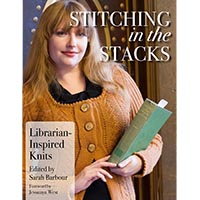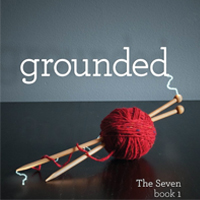Follow-up 1.1
Over the weekend, while I was driving around Eastern Pennsylvania looking for a new place for my family to live (they’re tearing our current home down this summer to make way for “luxury hi-rise apartments” now that the new Metro Spur is about to open…le sigh…), two very important comments came in to this site. Now that I’m home and settling back in, I wanted to highlight the comments for you in case you missed them.
The first is from Kathy who said:
Knitting keeps me in the HERE when I can’t HEAR. I’m hearing impaired and even with great technology, I miss a lot in small group conversations. Knitting enables me to sit quietly and BE part of the group. I look forward to my weekly small group to get some serious knitting done!
I found this fascinating for a couple of reasons.
First, I used to volunteer at the School for the Deaf in Riverside, CA through Ticktockers, and then again with a good friend at ASDB in Tucson, AZ. Aside from how much I enjoyed learning sign language (both ASL and signed English) I remember how tactile the kids were, as opposed to their counterparts in the hearing world. I’m sure we’ve all heard that when there is a disability of any sort, the brain does what it can to compensate (e.g., someone who is born blind or becomes blind often winds-up with heightened senses of hearing and/or smell) but the tactile nature of the blind students I worked with seemed to be (at least partly) born of security (i.e., if I can feel you next to me, I know exactly where you are rather than having to echolocate you). With the deaf students I got to know, I found their tactile ways to be an extension of their personality—a way to engage, make contact, make sure I attended to them because—were I deaf too—touching me would be another way of getting my attention and making sure I was attending to what they said.
And now, of course, we find that our knitting—doodling—crocheting, our touching sticks-and-string or pen-to-paper is another way of us saying to ourselves, “are you paying attention?”
Second, I wanted to ask Kathy a follow-up: Does the kitting help you follow the conversations around you, or simply keep you calm and happy while you float through sound, some of which is conversation you can follow and some of which you are letting wash over you? I wanted to ask because—while I’m not hard of hearing—I have often been in situations where I’m not following the conversation (e.g., a luncheon with a bunch of scientists who are all trying to out-jargon one another) and I’ve found myself impatiently aching for needles and yarn or a pad of paper to doodle on. I’m beginning to believe that our attention-focusing coping mechanism is doing even more that we’ve already learned here.
For situations like the aforementioned luncheon, I now always carry:
| one of these |  |
 |
| and one of these |  |
 |
And that brings me to the second important comment.
Susan says
I was really struck by your husband’s comment: “You knit so that you can keep yourself here.” That is it, exactly. I knit because my mind goes a thousand miles an hour, and if I am stuck sitting in one place (a meeting, a car, or bus trip), I need something to do. I like knitting, period. But when we are driving somewhere, or I’m in a meeting, I like that I am creating something physical. I like that I will have something to show for my time, even if it is only 2 inches of stockinette stitch for a sweater body. The pleasure I get from my knitting fills in the gaps (or something I don’t know how to describe, see note*) in the meeting and makes the whole experience better.
*Attempt at description of what I mean by “gaps” above: I read somewhere, sometime ago, that people can understand speech that is twice as fast as people can talk (i.e., take a recording of a sentence, edit it to eliminate all the pauses, empty spaces, and shorten up the words by condensing each sound, so that each sentence is only half as long as it is in real life, and it is still totally intelligible to the average listener). So you don’t need anywhere near as much time to HEAR a sentence as it takes to speak a sentence. The extra time, in my brain, is filled with the thoughts you were talking about, what to cook for dinner, where to go for lunch, how I can get my two cents in, etc., etc., etc.. Knitting fills those gaps also, and makes it possible to be HERE even if the HERE is somewhere that it is hard to sit still and BE.
Susan hit on something that hadn’t occurred to me before, but which I actually learned about directly in the training for my first teaching job.
I was (luckily, happily) hired by IRD the summer after my first set of teacher credential classes (before I was “ruined,” but after I’d learned some useful information, I suppose). I can honestly say I learned more practical teaching-reading information from John Boyd and the folks who ran the Long Beach, California IRD office than I did my credentialing program.* Later in my career, the state of California relicensed all of its in-service teachers to be Language Development Specialists (!) since some CA schools had up to 30 languages spoken by their student populations. The theory I learned during that re-licensing process backed up everything I’d learned from IRD, particularly this:
When we learn to read, we point at a word and say it which separates the words in the “hearing/seeing” parts of our brains:
| The | sun | did | not | shine, | |
| It | was | too | wet | to | play, |
| So | we | stayed | in | the | house |
| All | that | cold, | cold, | wet | day… |
This is not how our brains process language, but it is how we train our brains to process written language.
The reason we were able to understand the old FedEx ads
is exactly what Susan says: we can hear and understand far more/faster than we can think/read based on our childhood training. The IRD program I taught goes about re-training your brain to accept written language at a far faster rate than our brains think they can process written language. My best timing while teaching was reading over 1300 words per minute with perfect recall. Most folks read between 200–600 wpm.
So.
Couple that with the fact that audiobook apps like Audible allow you to speed up the narration, and what we get is…
Susan is SO right.
I think this is also why Bob and Ray were able to make us laugh so much about “slow talkers”—
—not because we’re rude or don’t want to listen, but because (for us?) it’s so easy to have those spaces filled up with all the other things we think about during the day… particularly if we’re not Cognitively Anchored.
Is it the curse of being an interesting/interested person?
Maybe so… but if we spread the word that we aren’t being rude by knitting or doodling, I think the Slow Talkers of America would find that they prefer our hands moving to us not hearing what they’re working so hard to share with us in the first place.












